Formal gardens compress centuries of design theory into crisp geometry, balanced plantings, and carefully chosen focal points. Their success lies less in rare plants than in disciplined structure: symmetry that calms the eye, repeated motifs that create rhythm, and a sense of progression that invites exploration. Whether you steward a stately estate or a modest courtyard, borrowing even one formal tactic—an aligned axis, a clipped hedge, a centred ornament—brings instant order and elegance. The ideas below distil classic principles into practical steps you can adapt to size, budget, and climate, proving that formal garden style is surprisingly flexible. Ready to start plotting straight lines?
1. Symmetrical Parterre Layout for Formal Garden Grandeur
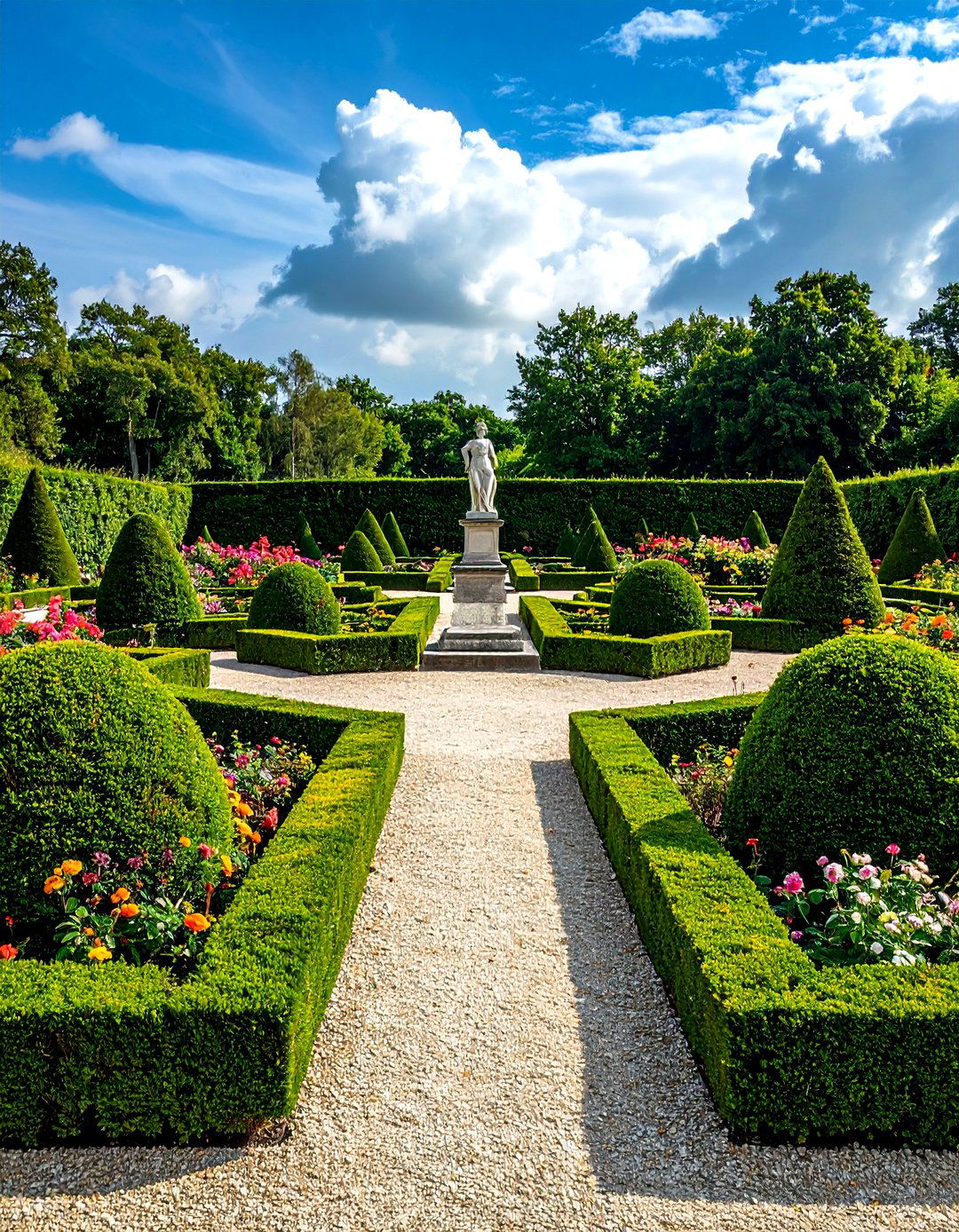
A grand parterre creates the stage on which the rest of a formal garden performs. Divide a level area into matching beds edged with low box or yew, then fill the shapes with gravel, seasonal flowers, or evergreen groundcovers so the pattern stays legible all year. Viewed from a terrace, the repeated motifs read like embroidery laid on the lawn, emphasising proportion and precision. Keep paths narrow to maximise planting yet wide enough for maintenance, and place a statue, urn, or fountain at the crossing point for instant drama. Even a small backyard can host a simplified parterre grid.
2. Intricate Knot Garden Patterns for a Formal Garden Twist
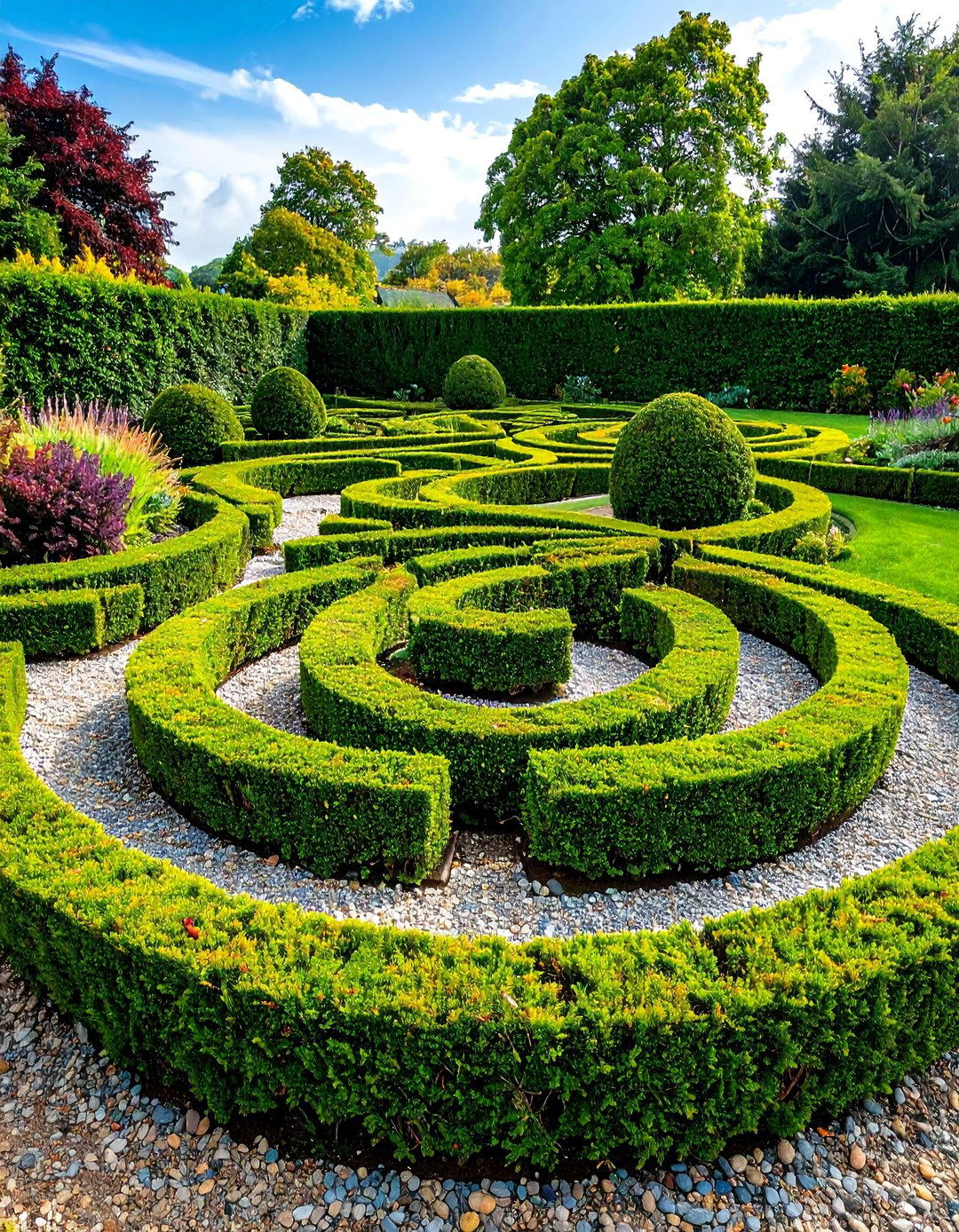
Unlike the flat geometry of a parterre, a knot garden weaves low hedges into loops and Celtic-like braids that appear to interlace. Choose aromatic herbs or evergreen box for the outlines, then infill with coloured gravel, flowering thyme, or silver santolina to heighten contrast. Early Elizabethan designers prized the symbolic nature of knots, seeing the endless lines as signs of eternity and order, and the style still offers a showy focal point in a compact footprint. Lay out the pattern full-scale with hose or sand before planting, and trim hedges little and often for crisp edges.
3. Axial Pathway and Statue Anchor for Formal Garden Drama
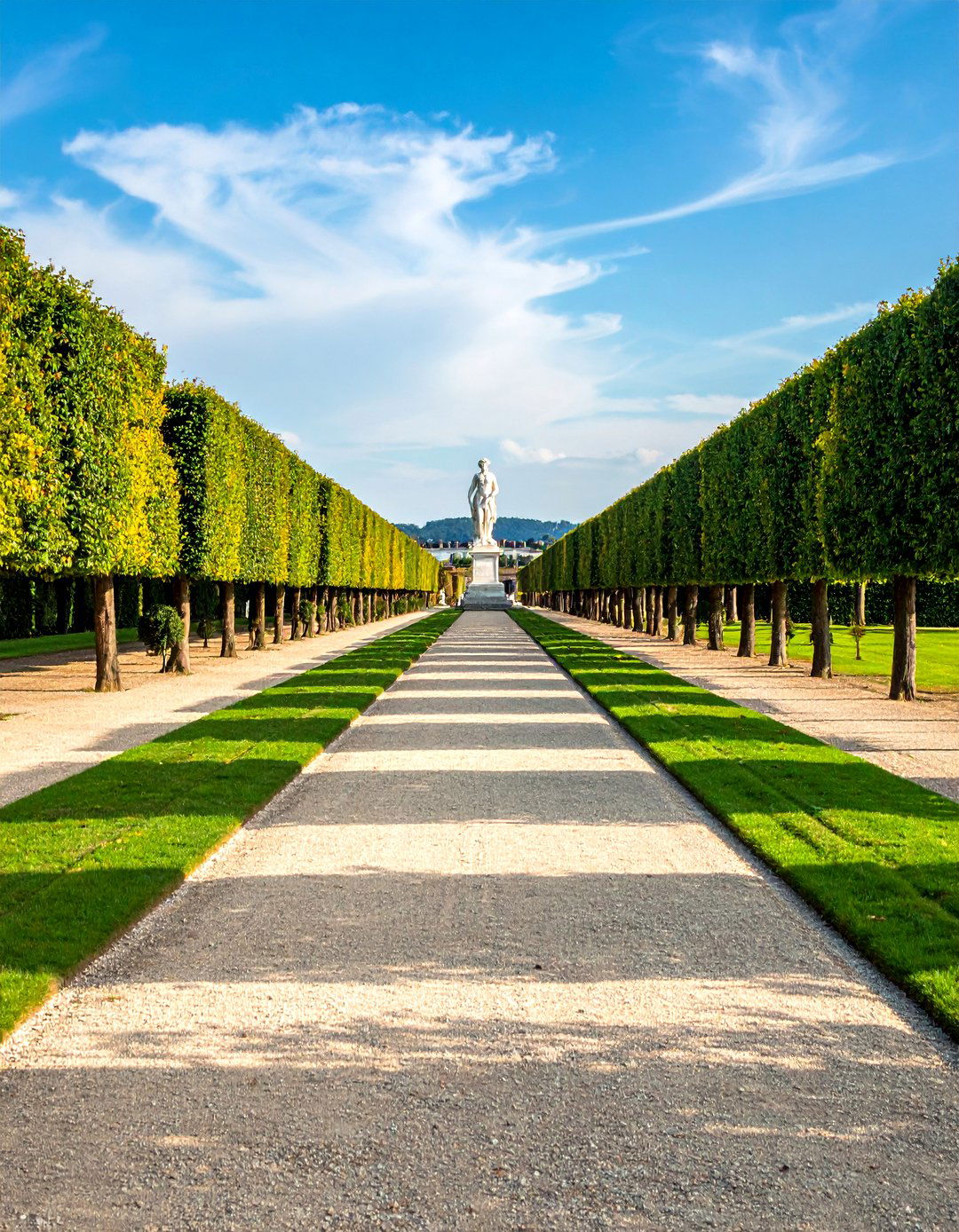
A straight path that runs the full length of a formal garden pulls every element into alignment and frames a powerful destination. Build the walk in stone, brick, or compacted gravel, run clipped hedges or repeated shrubs along both sides, and terminate the vista with a statue or fountain slightly elevated to command attention. Mirrored plantings reinforce serenity while steering visitors forward. If space is tight, shorten the axis but keep the same sense of procession by using a single focal ornament chosen for scale and character.
4. Pleached Tree Allée Shaping a Formal Garden Corridor

Take a living colonnade of pleached hornbeams or limes and you create vertical walls and a leafy ceiling without building walls or roof beams. Tying young branches to horizontal frames, then pruning annually, yields a green tunnel that screens neighbours, divides spaces, and casts dramatic shadows. Because trunks are clear-stemmed, under-planting with bulbs or low hedging remains easy, preserving the disciplined look. Let the allée lead to a gate, bench, or sculpture for a satisfying reveal, and schedule midsummer trims to hold the crisp outline.
5. Topiary Sculptures Elevating Formal Garden Structure
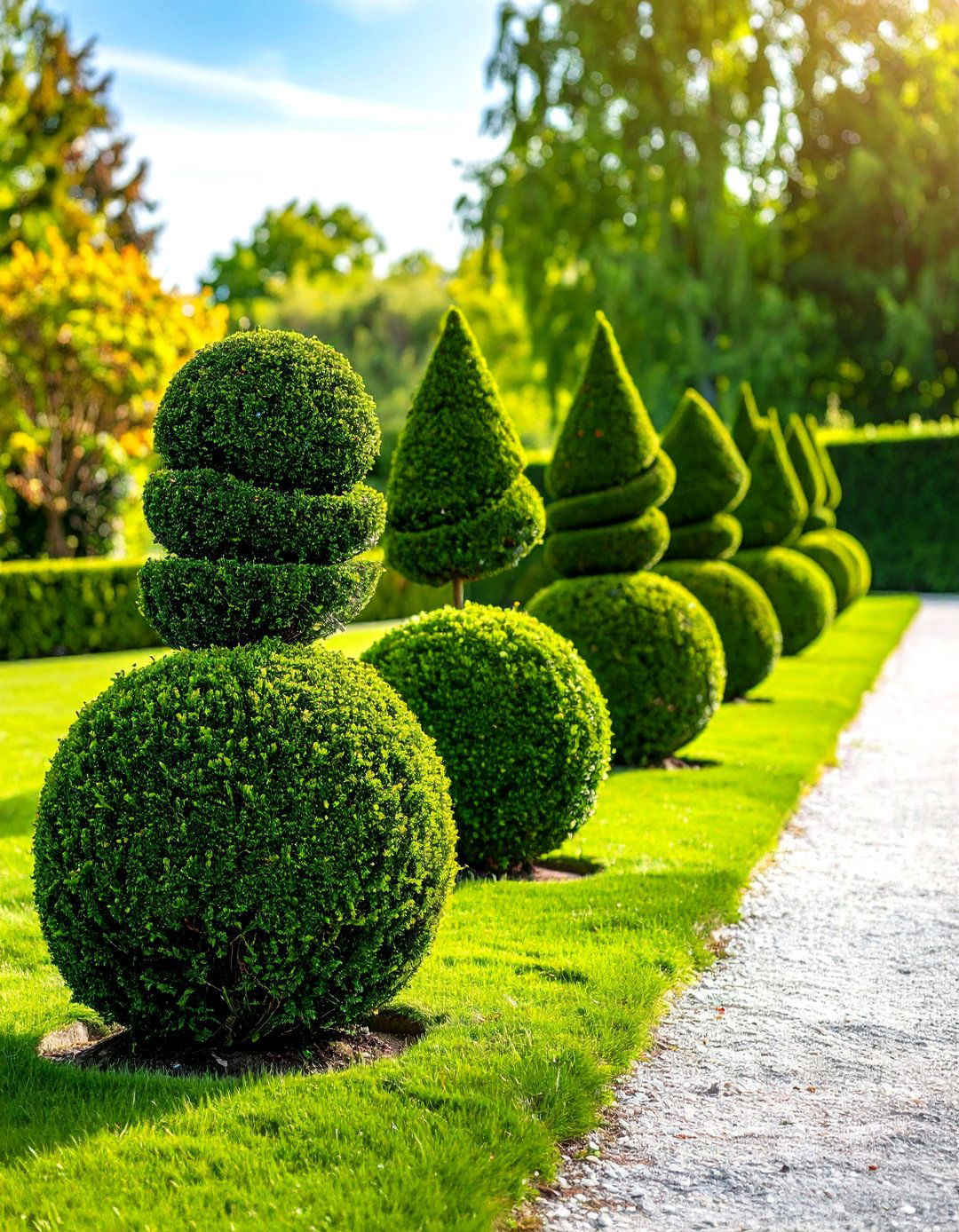
Certainly, nothing signals a formal garden faster than a parade of topiary balls, cones, or spirals standing like sentries beside a path. Clip box, yew, or holm oak into geometric forms that echo architectural features, or go playful with animal shapes if you enjoy detailed snipping. Keep blades sharp, disinfect between plants, and feed lightly after each cut to encourage dense regrowth that hides slips. Where box caterpillar is a threat, substitute yew or Ilex crenata for the same sculptural result.
6. Mirror-Like Reflecting Pool to Double Your Formal Garden Views
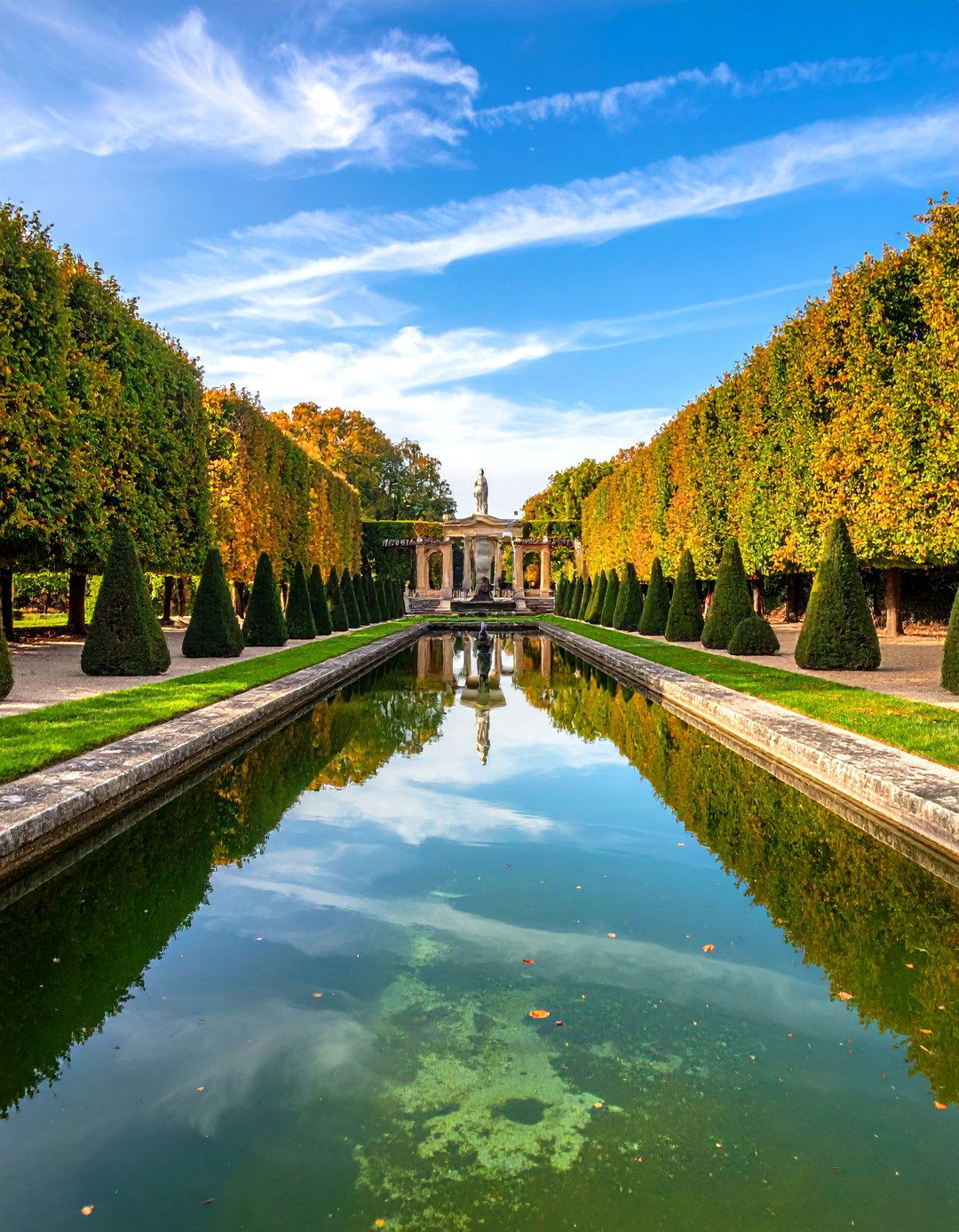
A still sheet of water behaves like a giant mirror, doubling sky, foliage, and statuary while adding calm. Place the pool on the garden’s main axis, keep edges simple so the eye reads one horizontal plane, and flank it with evenly spaced clipped hedges to frame reflections. Designers advise choosing the longest rectangle the site will bear, as generous proportion amplifies the illusion of depth. Sub-surface pumps keep water clear without disturbing the glassy surface that makes reflecting pools so mesmerising.
7. Symmetrical Rose Beds Creating a Perfumed Formal Garden
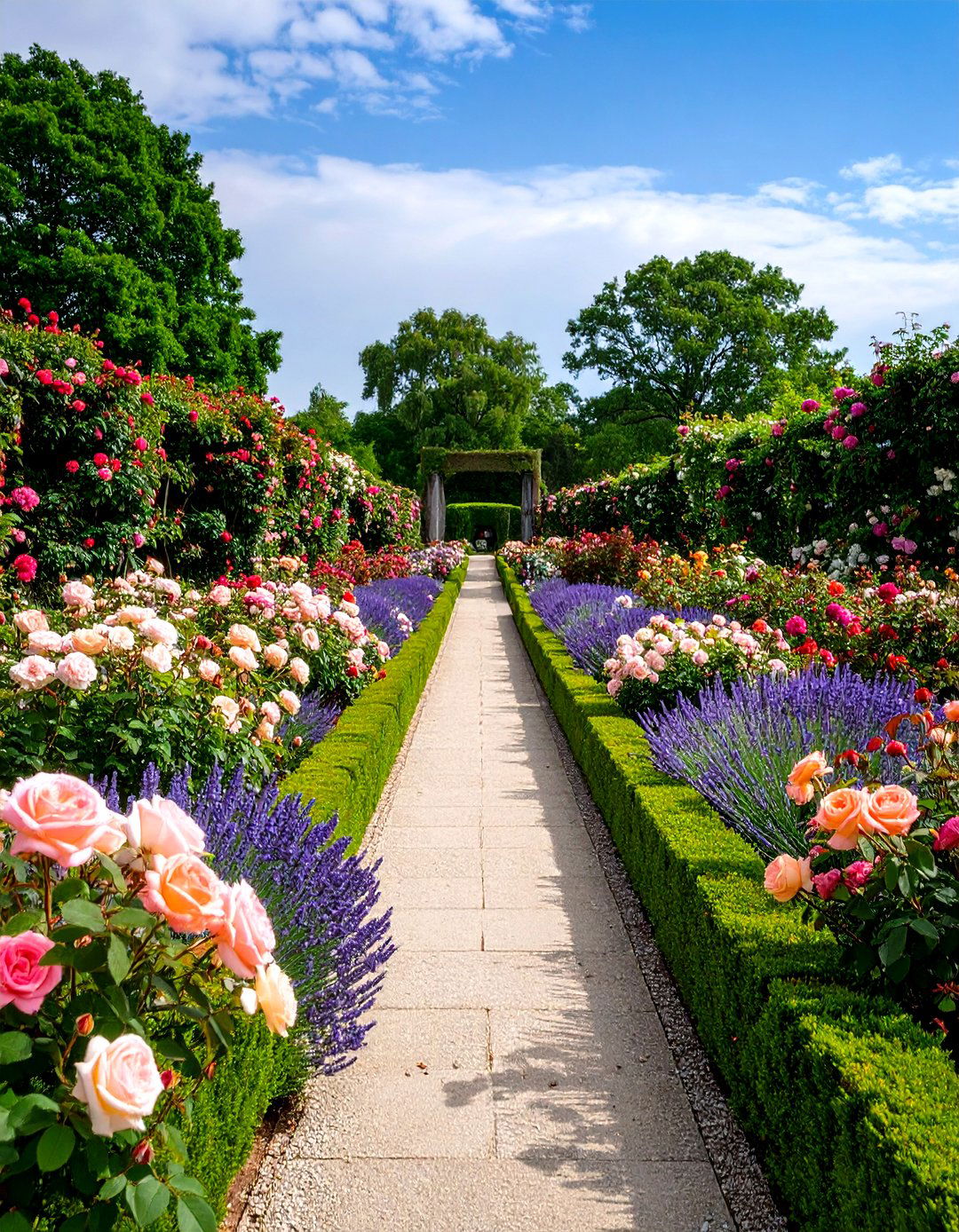
Looking for fragrance and form? A dedicated rose garden arranged in neat quadrants delivers both. Hybrid teas or floribundas stand upright and repeat-bloom, making them perfect for tightly clipped rectangles bordered by box. Space plants evenly, under-plant with lavender for soft colour at ground level, and use metal obelisks for climbers at central points so winter structure remains. Maintain uniform pruning height each February to keep the layout looking level from every angle.
8. Herb Quadrant Courtyard for a Productive Formal Garden
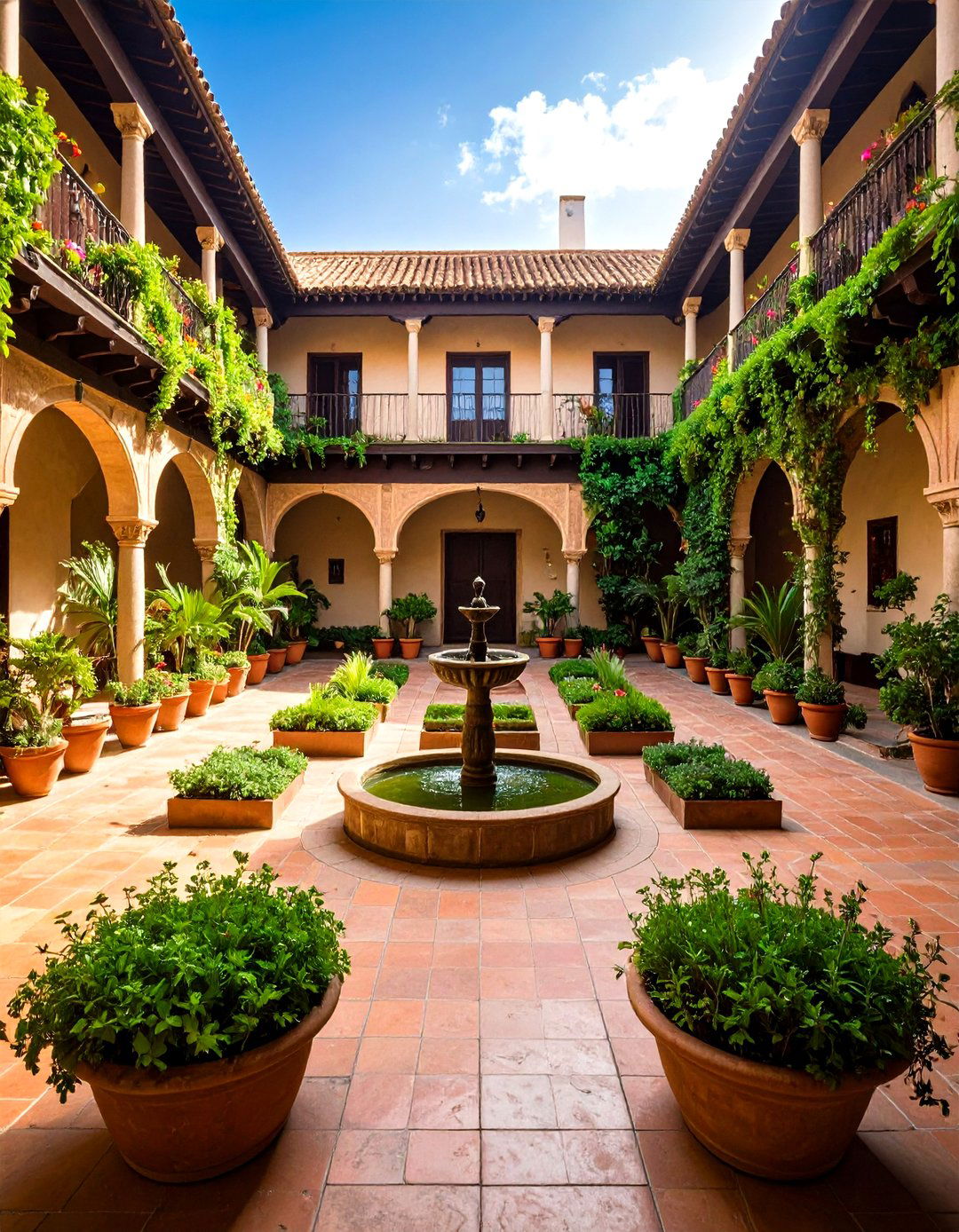
Convert a sunny corner into a miniature cloister of herbs set out in four equal beds around a fountain or sundial. Cross-shaped paths allow easy harvest while the repeated geometry roots the space firmly in formal tradition. Tall rosemary anchors corners; lower thyme and chives keep sightlines clear. Raised brick edges accentuate lines and simplify maintenance, while grouping Mediterranean herbs in the driest quadrant balances their watering needs against thirstier species opposite.
9. Espaliered Fruit Walls Maximising Formal Garden Space

Espaliering pears, apples, or peaches against walls or freestanding trellises turns the vertical plane into productive sculpture. Horizontal tiers mirror the strict lines of a formal garden, and residual wall heat boosts ripening. Train one pair of branches at a time, tying shoots to wires and removing competing growth until the frame is full, then spur-prune each winter. Companion bulbs at the base add seasonal colour without stealing nutrients from the shallow root zone.
10. Boxwood Edging for Crisp Formal Garden Lines
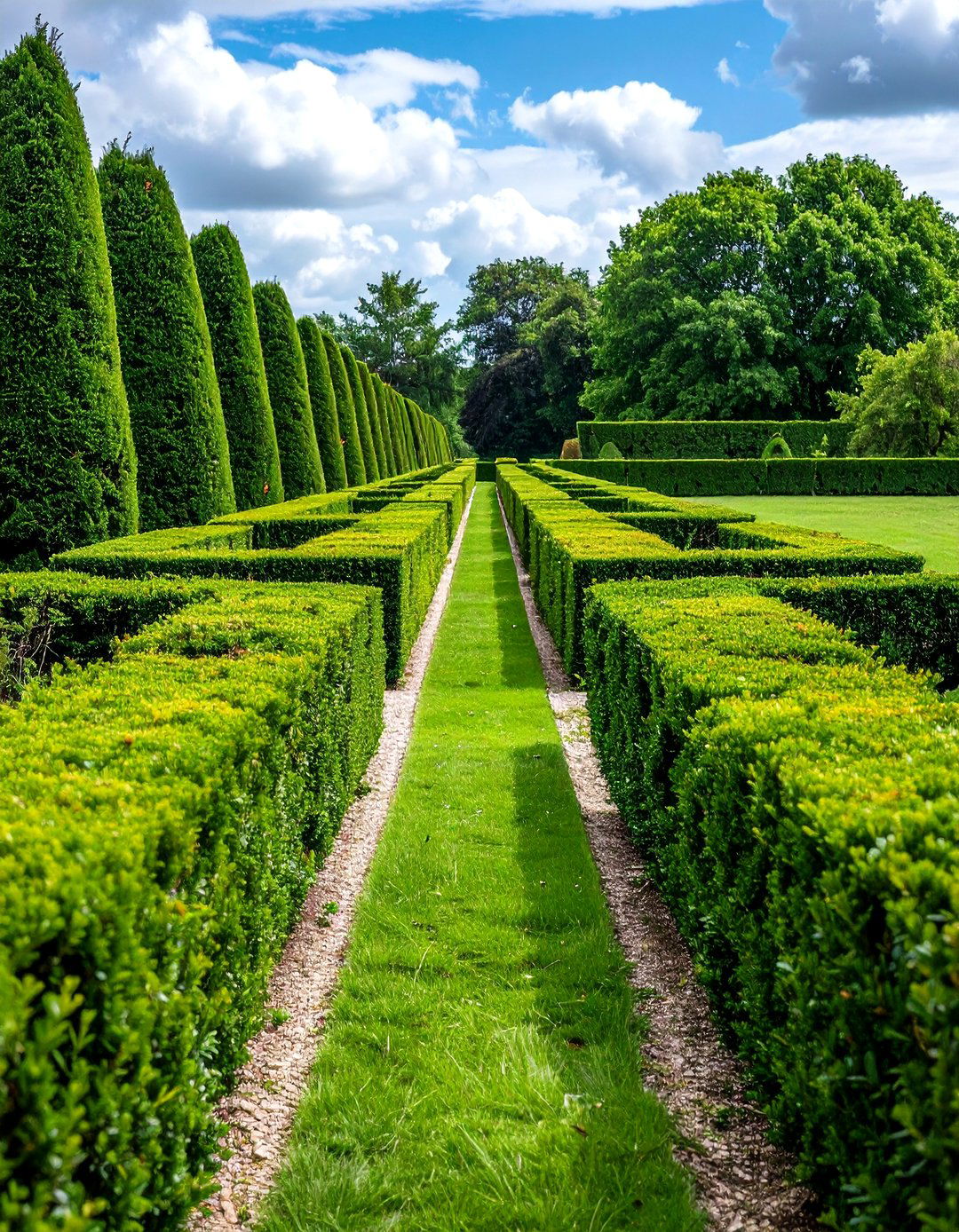
Low box hedges trimmed to a uniform 20–30 cm draw razor-sharp outlines round beds, paths, and lawn panels, acting like picture frames for the planting inside. Because box tolerates frequent clipping and stays evergreen, it supplies year-round architecture—crucial when perennials retreat. Rest a straight board across the hedge top as a guide and trim little and often. Where box pests threaten, dwarf yew or lonicera offers an equally tidy substitute.
11. Checkerboard Lawn Panels to Add Playful Formal Garden Order
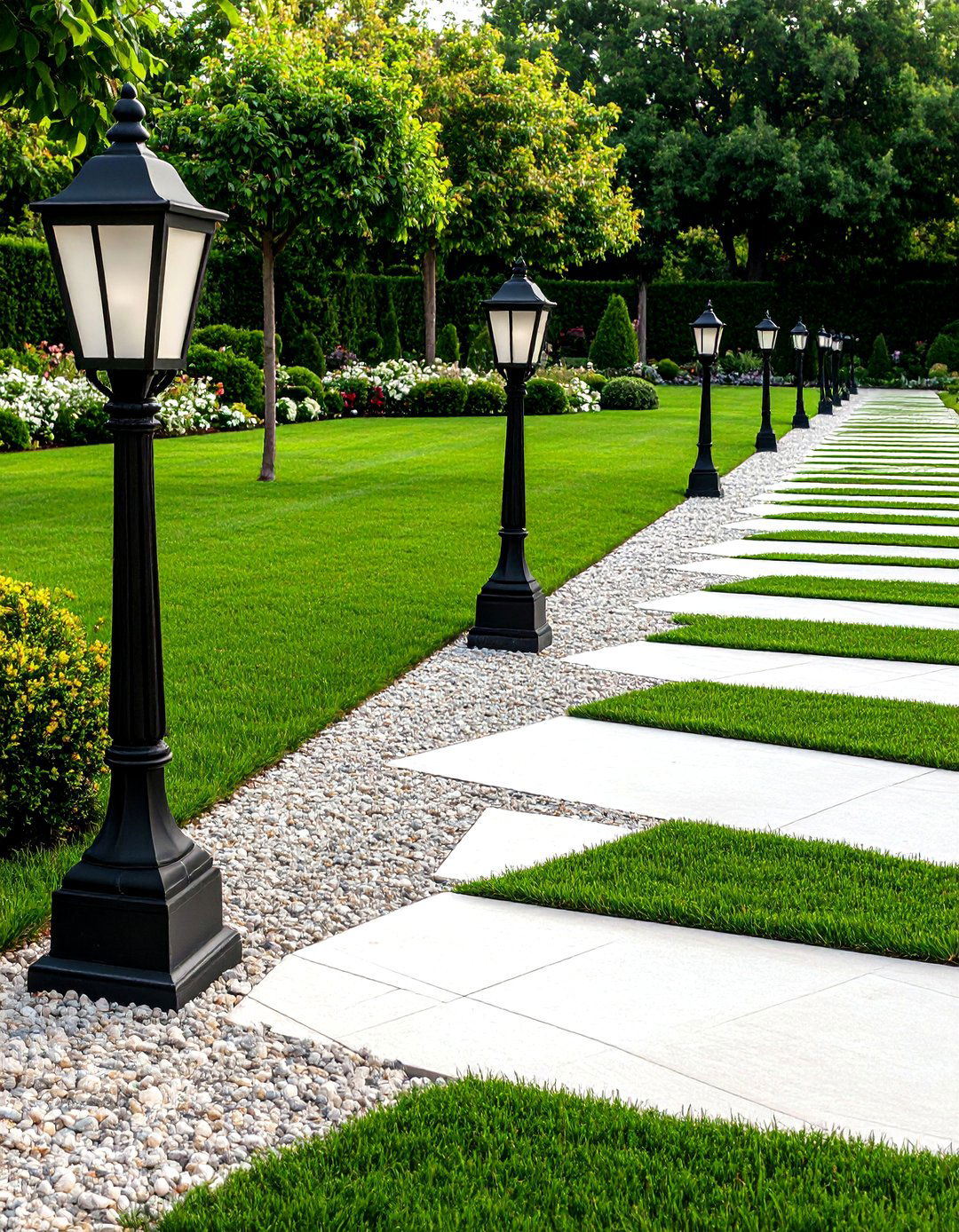
A checkerboard layout alternates squares of turf with gravel, thyme, or pavers, creating a giant chessboard that is both whimsical and rigorously geometric. The pattern reads beautifully from an upstairs window and halves mowing. Mark out equal squares with string and stakes, lay edging strips between materials, and choose drought-tolerant grass mixes to prevent scorch. Low bollard lights at corners emphasise the grid after dark, extending enjoyment into evening hours.
12. Orangerie Courtyard Bringing Exotic Flair to a Formal Garden

Channel eighteenth-century glamour by enclosing a paved rectangle with high glass walls or a lean-to glazed structure, then centre potted citrus trees beneath clerestory light. Historically, orangeries sheltered tender fruit through freezing winters; today even a modest greenhouse with brick knee-walls can recreate the aesthetic. Keep pots on wheeled bases for easy movement, under-plant with scented pelargoniums for extra perfume, and paint interior woodwork white to bounce light and accentuate symmetry.
13. Classical Statuary Focal Points in the Formal Garden

A single statue placed where axes cross supplies instant hierarchy. The human form adds scale and story, while a plinth elevates it above nearby hedges. Designers often repeat statues in pairs to bracket terraces or garden rooms, echoing the mirroring principle that underpins formal layouts. Choose weather-resistant stone, set the base on compacted hardcore to stop sinking, and surround with low evergreen planting so attention remains on the sculpted silhouette.
14. Linear Rill Water Channel for Subtle Formal Garden Movement
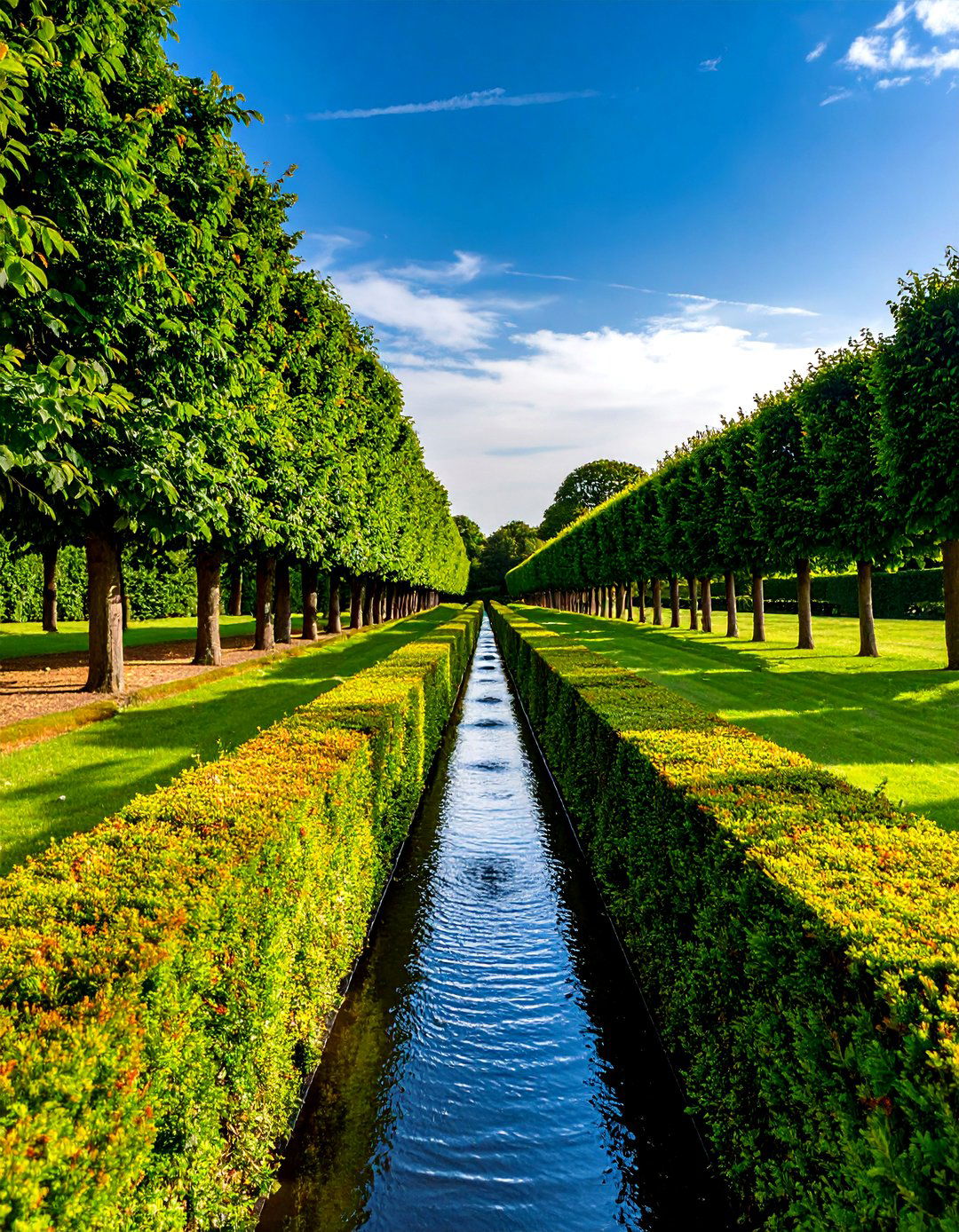
A rill—nothing more than a narrow, shallow canal—threads water quietly through a formal garden, linking features and reflecting light without dominating the scene. Built in stone or rendered concrete, the channel must sit perfectly level so the surface stays razor smooth; even a millimetre off shows immediately. Discreet grills hide pumps and filters while preserving continuity. Plant clipped hedges or aromatic groundcovers tight to each edge so foliage softens the hard line yet preserves its straightness.
15. Pergola Walkway Covered in Climbers for a Shaded Formal Garden Passage
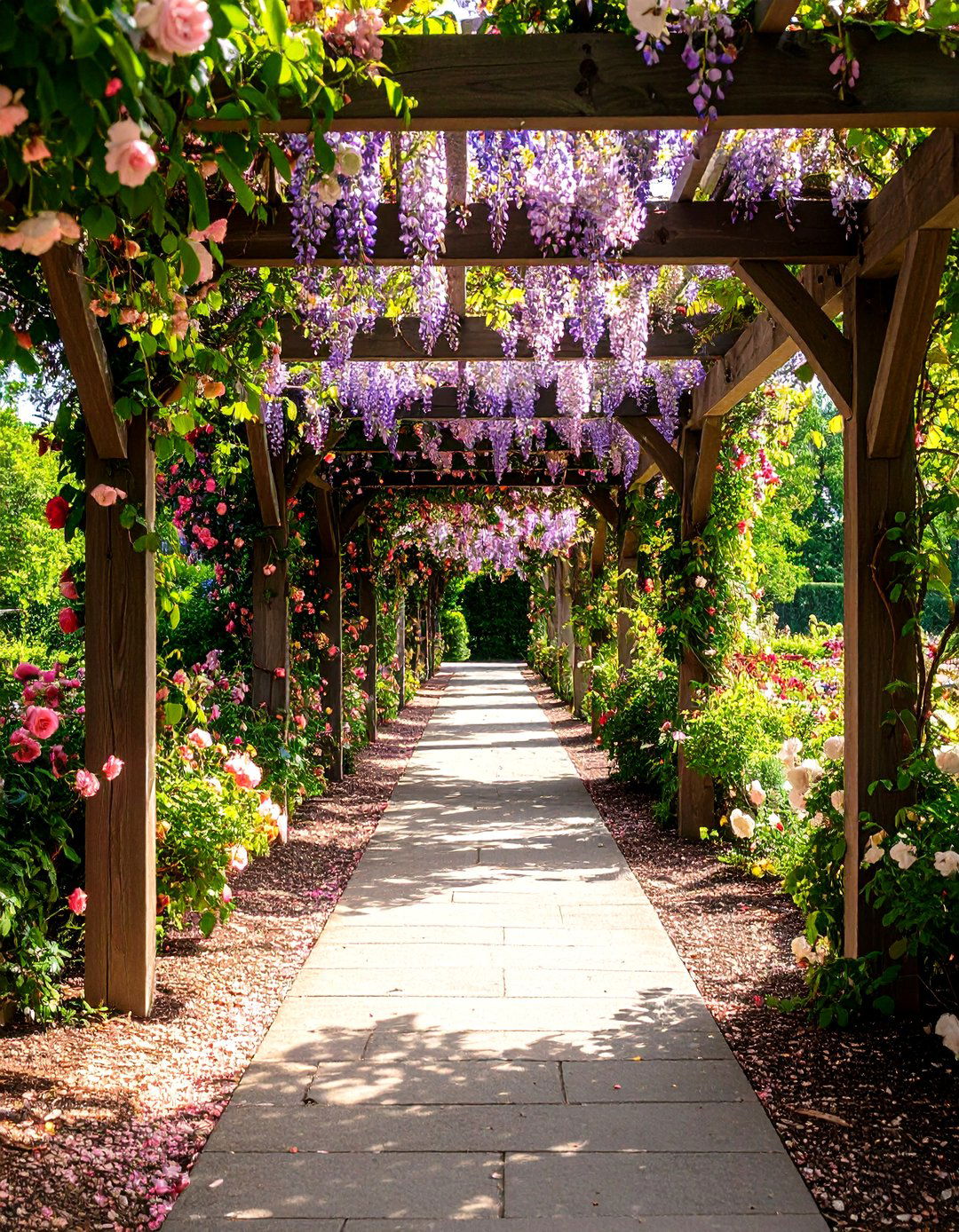
Stretch a timber or metal pergola along a path and you create both shade and ceremony. Train climbing roses, clematis, or wisteria evenly up the posts, pruning side shoots back to two buds each winter to keep growth in check and blooms at eye level. The parallel uprights echo the garden’s geometry, and the roof frames sky views in controlled intervals. Even in winter the bare framework reads as strong architecture, so choose materials proportionate to nearby façades and hedges.
16. Monochromatic Planting Scheme Elevating Formal Garden Sophistication

Restricting a border to variations of one hue—white and silver, for example—intensifies form and texture, hallmarks of a formal garden. Combine glossy white tulips, frothy gypsophila, variegated artemisia, and silver arundo to add depth without colour clutter. Vary leaf shapes and bloom sizes so the display remains lively despite the tight palette. A single contrasting obelisk then pops dramatically against the restrained backdrop. Regular deadheading keeps the look pristine and prevents stray seedlings muddying the scheme.
17. Paired Urns Punctuating Formal Garden Axes
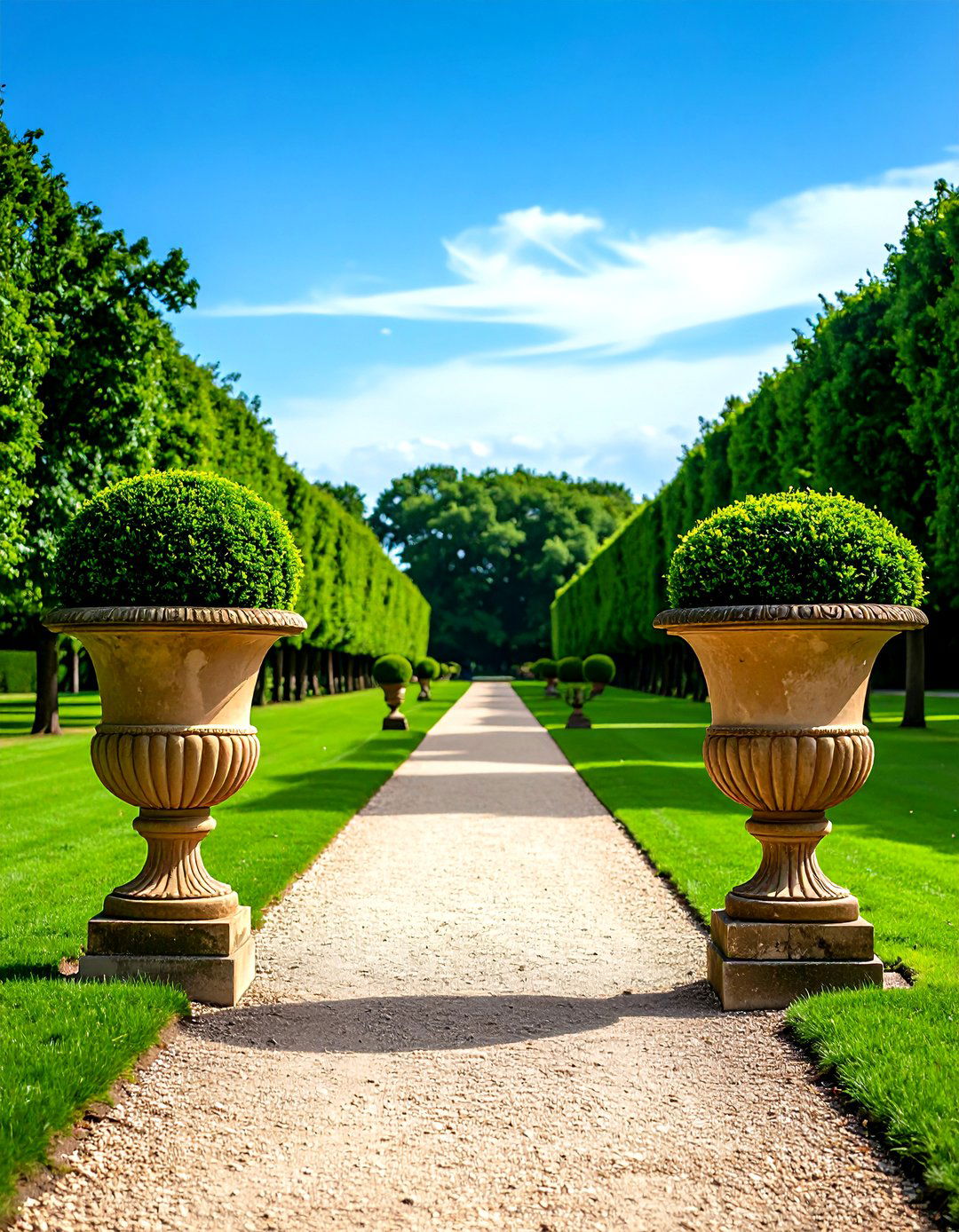
Placing a matching pair of ornamental urns at path mouths or terrace steps signals transition while reinforcing balance. Scale matters: the vessel should stand roughly one-third the height of the nearest wall or hedge, anchoring the view without dominating it. Fill with clipped box domes or seasonal bedding changed four times a year for colour that respects the orderliness beneath. In small gardens, a single statement urn centred on a gravel square can replace a fountain, delivering classical heft with less plumbing.
18. Geometric Paving Patterns Grounding the Formal Garden
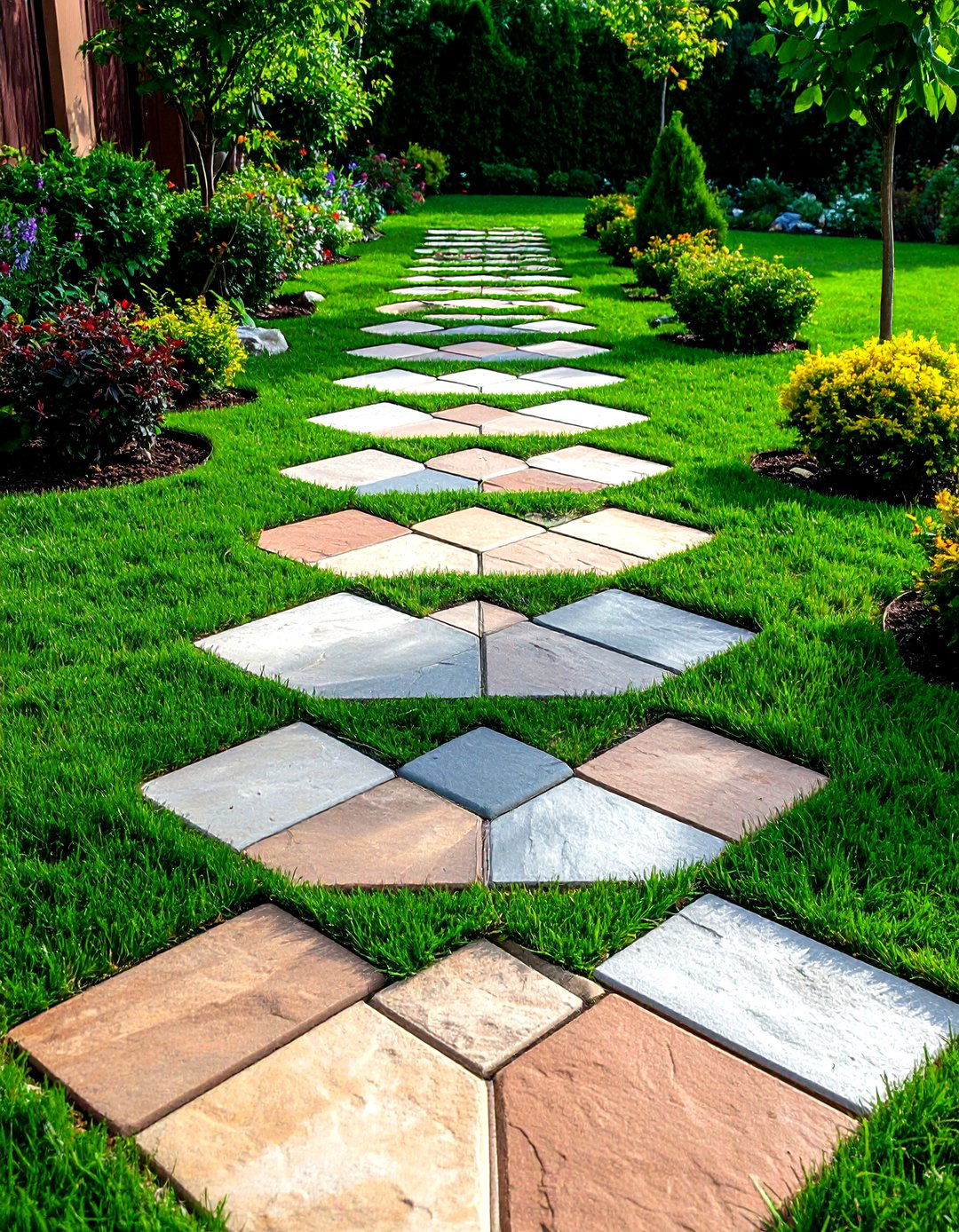
Squares, diamonds, and herringbone bricks underfoot echo the straight lines above, tying planting and hardscape into one disciplined whole. Lay paving on a compacted sub-base and draw the design full-scale to ensure joints align with hedge corners and bed edges. Contrasting inlays of darker stone or clay pavers emphasise geometry, while repeating modules simplifies cutting waste. Edge every path with metal strip so adjacent grass cannot creep in and blur the pattern.
19. Framed Lawn Panel Offering Breathing Space in a Formal Garden

A level, rectangular lawn bordered by narrow clipped hedges or brick edging acts like a green rug, giving the eye a rest between ornate beds. Keep length and width in the golden ratio or mirror house dimensions for harmony, and mow in alternating directions to enhance the velvety finish. Because the lawn is a design element, resist placing pots on its surface; instead frame seating on adjoining terraces. Overseed thin patches each spring and scarify lightly to maintain the flawless carpet formal gardens rely on.
20. Sundial Centerpiece Linking Time and Formal Garden Design

Crown a circular node where paths meet with a sundial mounted on a simple plinth, and you weld astronomy to ornament. Align the gnomon to true north, raise the dial high enough to clear surrounding foliage, and encircle the base with low herbs so shadows fall cleanly. The radial design contrasts nicely with the straight lines elsewhere, while metal or stone finishes weather to match antique statues and urns. An occasional polish keeps inscriptions legible without erasing patina.
Conclusion:
Order, balance, and a touch of theatre define every successful formal garden. Whether you adopt a single clipped hedge or commit to an entire parterre, the consistent themes remain: strong geometry, repeated planting, and carefully positioned focal points. Blend structural evergreens with seasonal colour, add quiet water or reflective surfaces for movement, and keep maintenance rhythms as regular as your planting lines. Layering these classic techniques creates an outdoor room that feels calm, cohesive, and timeless—proof that the formal garden tradition still offers fresh inspiration for contemporary spaces.


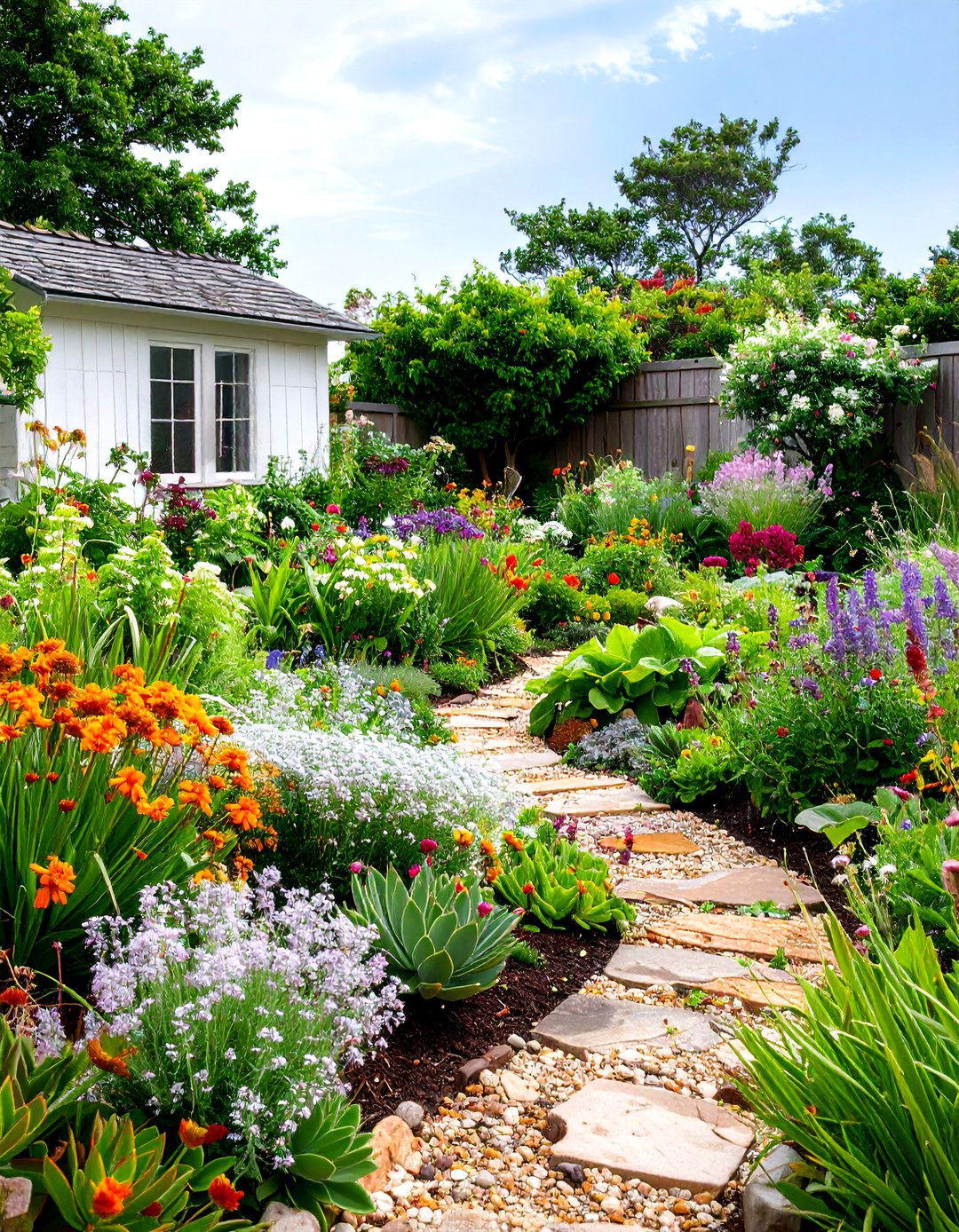
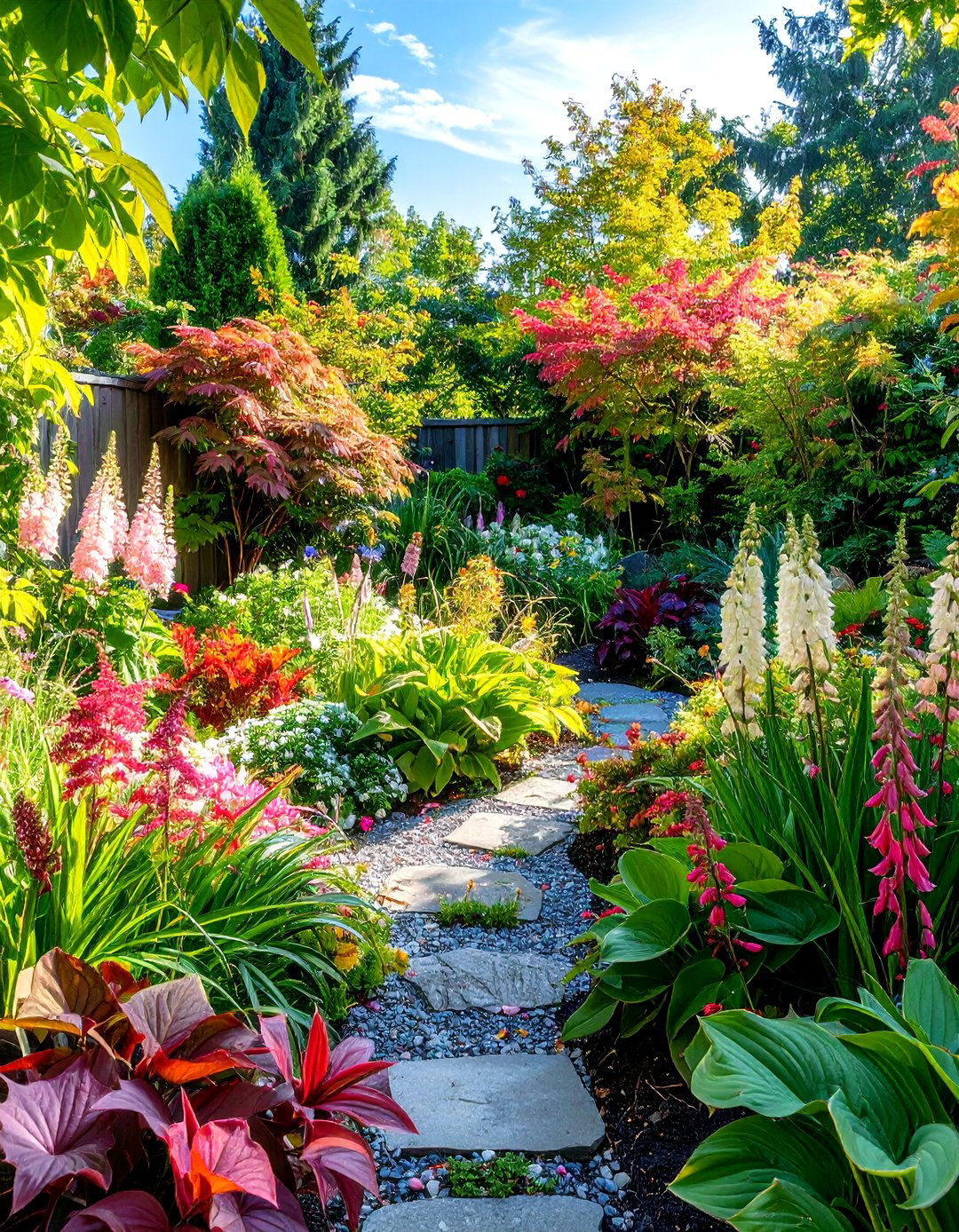



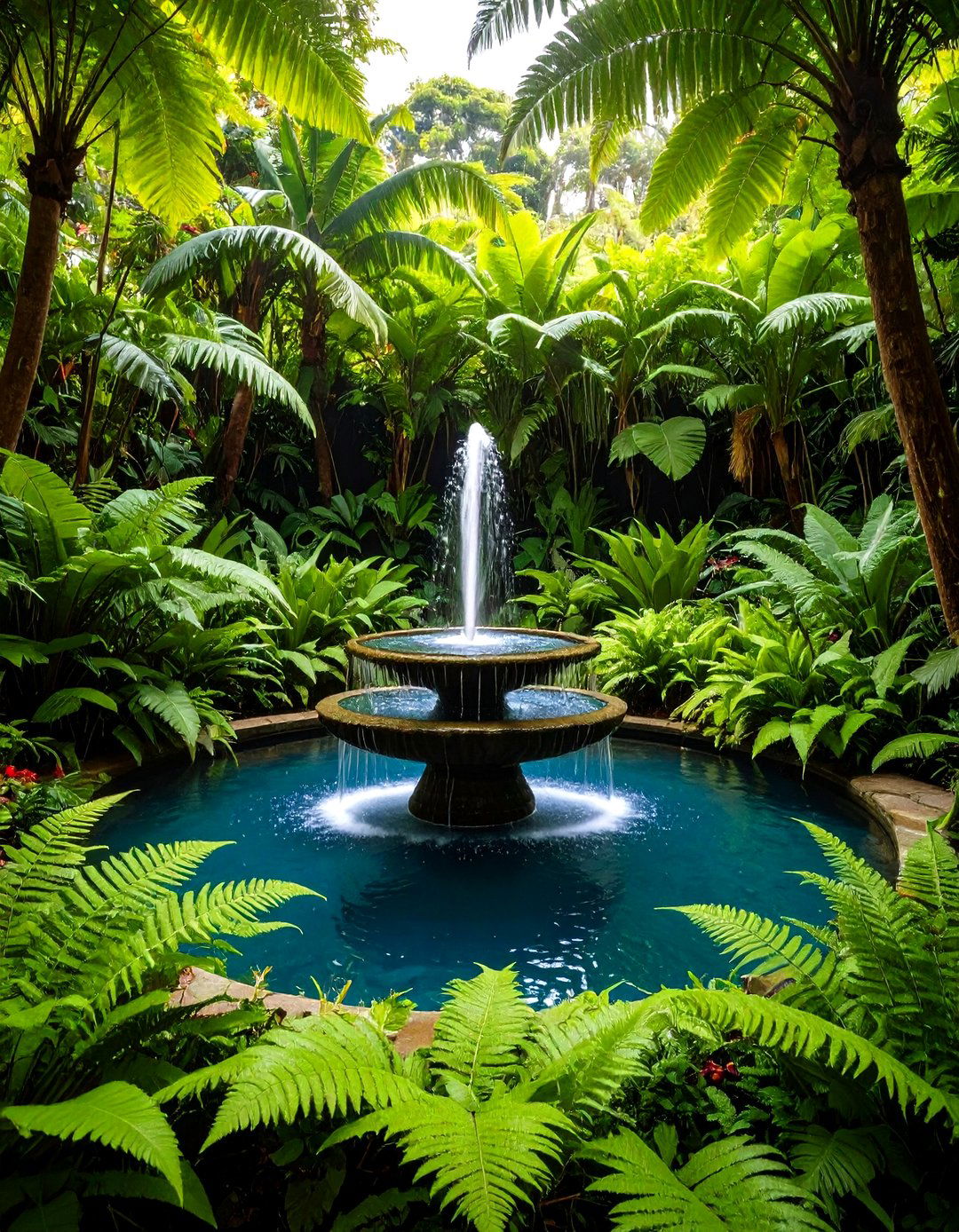
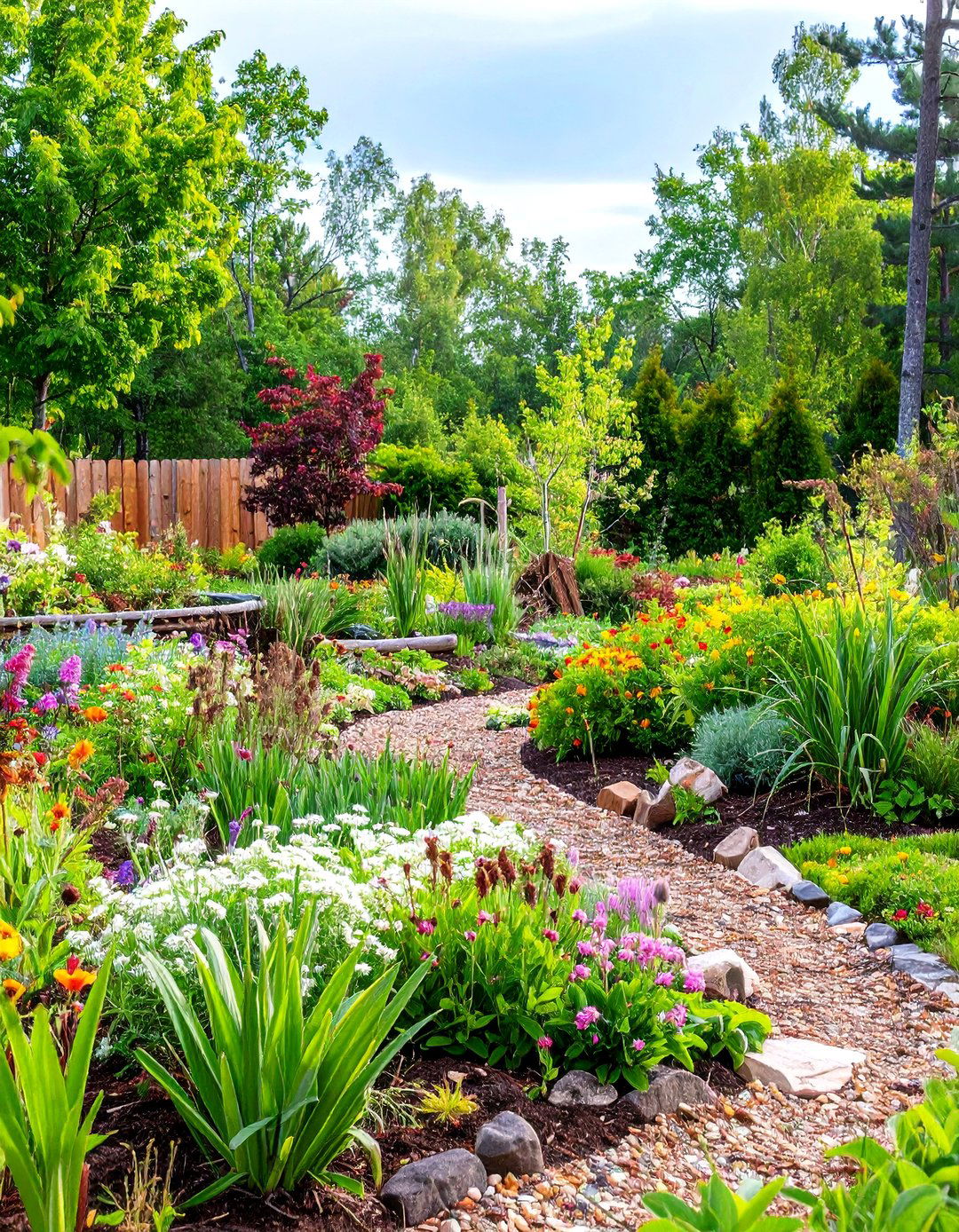
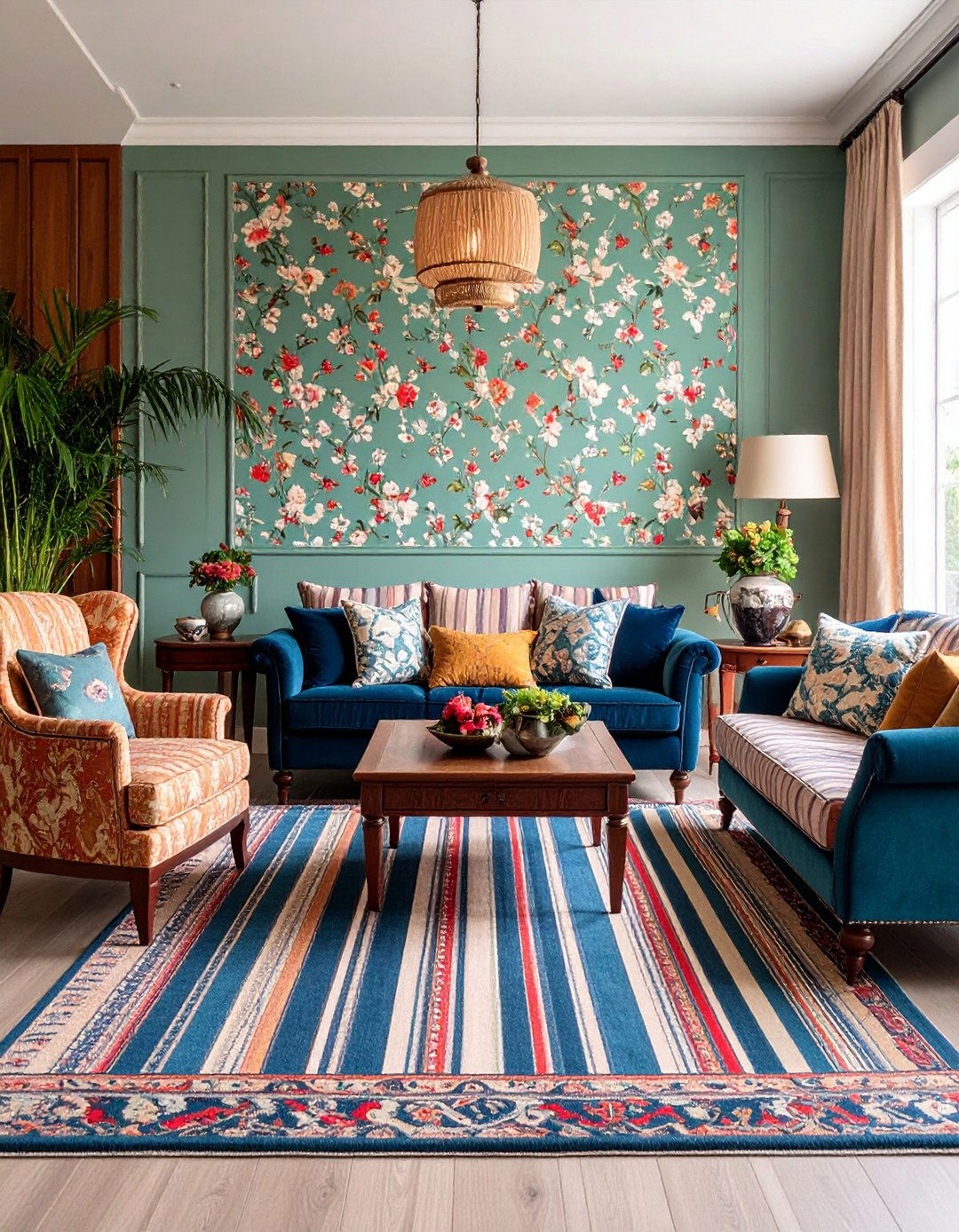

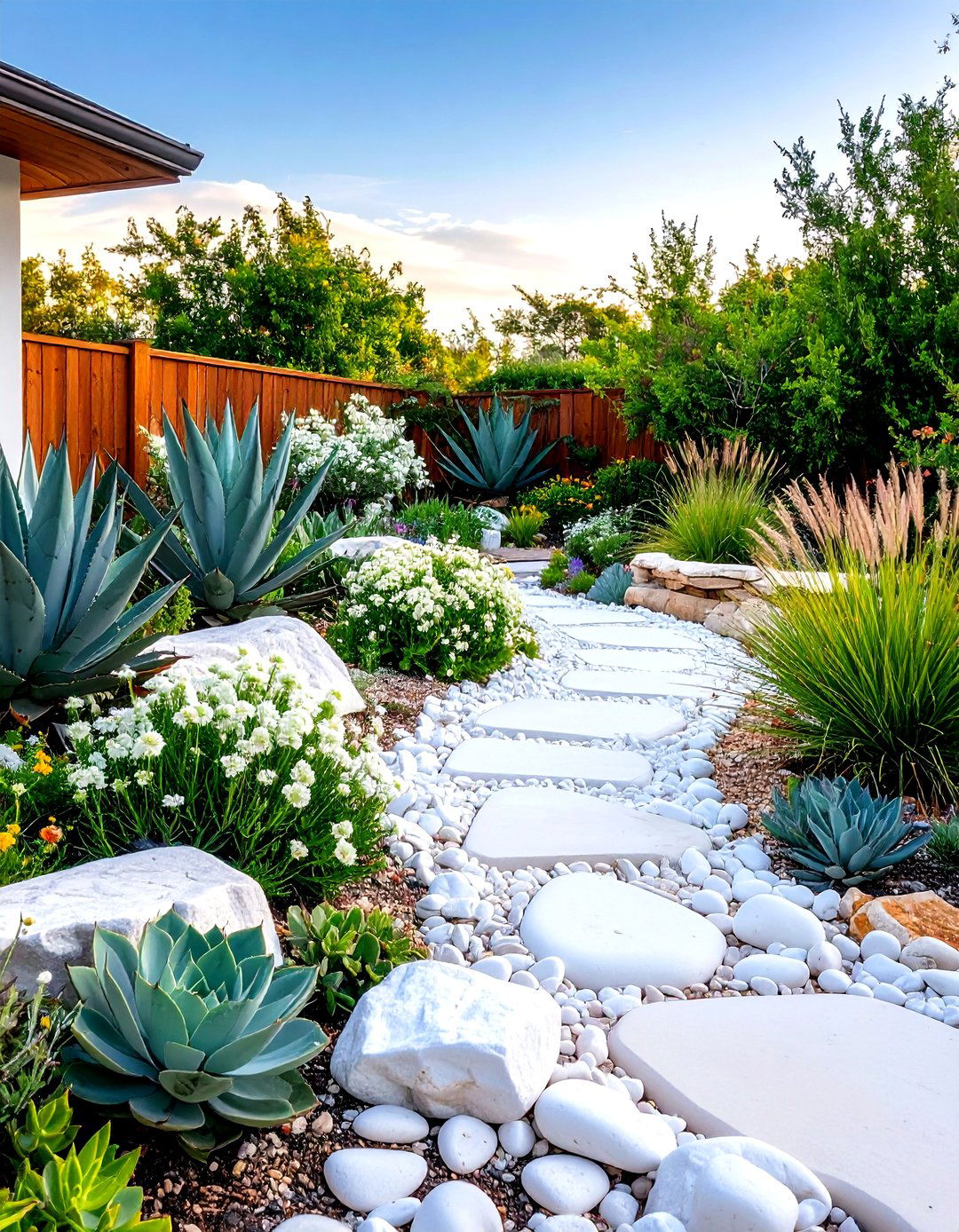


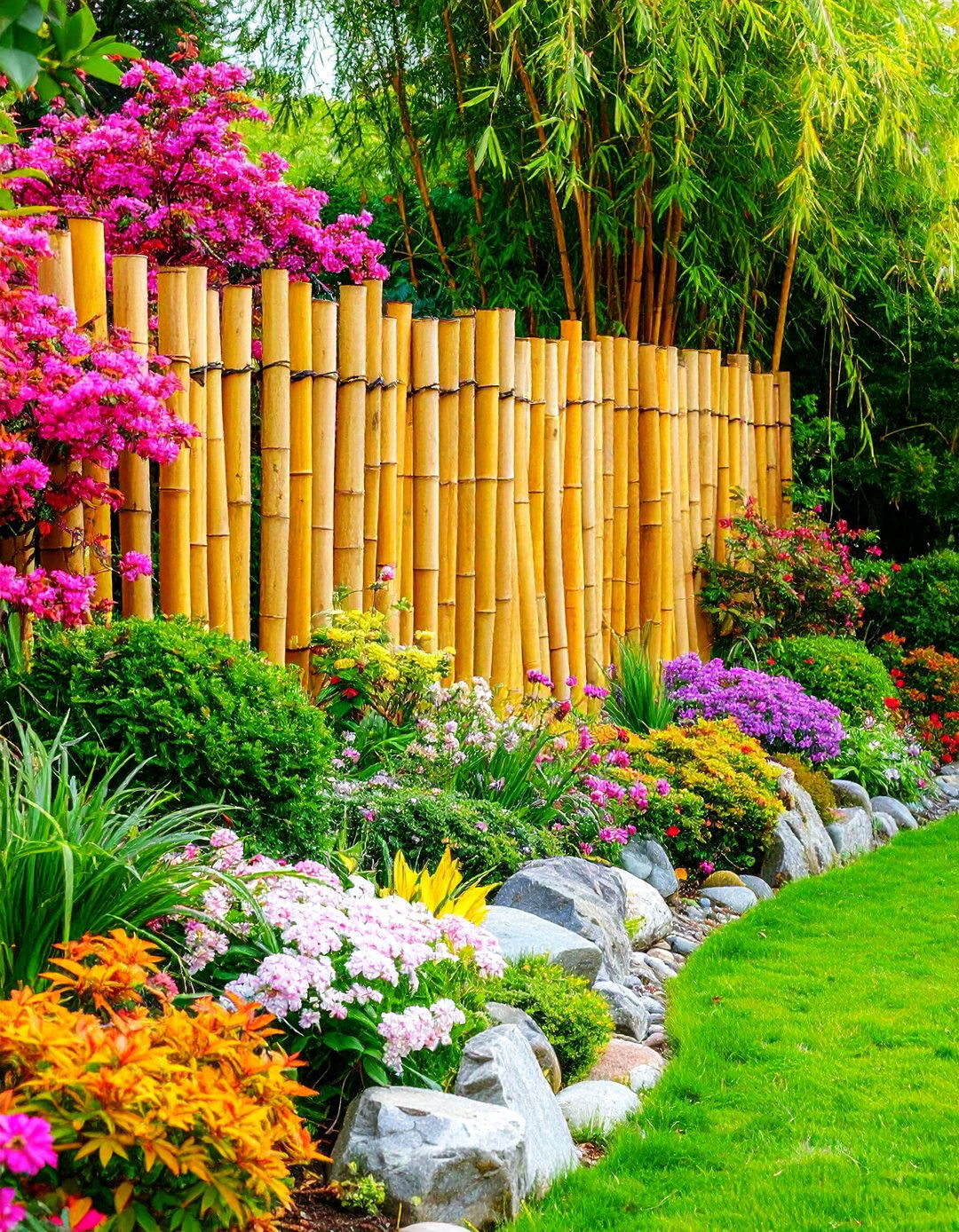

Leave a Reply